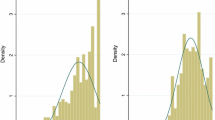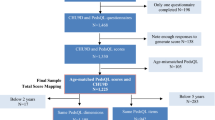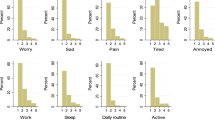Abstract
Background
The Paediatric Quality of Life InventoryTM 4.0 Generic Core Scales (PedsQL) is a non-preference based instrument for assessing health related quality of life (HRQoL) in children. Recent papers presented algorithms of parental proxy and short-form versions of the PedsQL onto the validated preference-based Child Health Utility 9D (CHU9D) instrument, to enable conversion of PedsQL scores to quality adjusted life years for use in economic evaluation. However, further research was needed to both validate these algorithms, and assess if use of the full 23-item PedsQL self-report instrument is preferable to other PedsQL versions for mapping onto child self-report CHU9D utilities.
Objective
To develop a mapping algorithm for converting the 23-item PedsQL instrument onto the CHU9D instrument and provide an external validation of two recently published algorithms that might be considered alternatives.
Methods
Data from children in the Longitudinal Study of Australian Children (LSAC) were used (N = 1801). Six econometric methods were compared to identify the best algorithms, assessed against a series of goodness-of-fit criteria. The same data and goodness-of-fit criteria were used in the external validation exercise for previously published mapping algorithms.
Results
The optimal mapping algorithm was identified, which used PedsQL dimension scores to predict the CHU9D utilities. It performed well against standard goodness-of-fit tests. The external validation exercise revealed the recently published alternative algorithms also performed relatively well.
Conclusion
The identified mapping algorithms can be used to facilitate cost-utility analysis in comparable populations when only the PedsQL instrument is available. Results from this population indicate the algorithms identified in this paper are well suited for estimating CHU9D self-report utilities when the full 23-item self-report PedsQL instrument has been used.



Similar content being viewed by others
Change history
28 January 2020
In the original publication of the article, the equation CHU9D<Subscript>Predicted</Subscript> = exp(BETA<Subscript>Prediction</Subscript>)∕(1 + exp(BETA<Subscript>Prediction</Subscript>)) was formatted incorrectly under Model 2.
Notes
Whilst the need for a representative Australian sample is not applicable in this analysis, survey weights are available for research investigations that do have that requirement.
The 23 item PedsQL instrument enables calculation of overall and dimension-level scores even when some individual questions/items have not been answered (see https://www.pedsql.org/score.html).
Note that we initially also considered the beta mixture regression proposed by Gray and Hernández-Alava [23]; however, the single class beta regression was found to perform better than latent class regressions for each model-level, as such the beta mixture regression results were omitted. The multivariable fractional polynomials (MFP) regression approach (which was estimated using a robust regression model) was also initially investigated for inclusion as a seventh econometric estimation method. However, it was ruled out for inclusion as it was found to be unstable in Model 2 validations, producing a lower bound estimate of − 0.4825 CHU9D utility score in the validation exercise (further MFP results are available upon request).
Overall 26.2% children reported any medical condition. The most commonly reported condition was asthma (reported by 13.5% children); others include allergy, blood clotting condition, bone disorder, broken bone(s) that are still healing, chronic or recurring pain/discomfort, diabetes, difficulty gripping or holding things, hearing loss, incomplete use of arms/fingers/feet/legs, infection or injury to toes/toenails, mental illnesses, restriction in physical activities, shortness of breath causing restriction and vision loss.
References
Brazier, J., Ratcliffe, J., Tsuchiya, A., & Salomon, J. (2007). Measuring and valuing health benefits for economic evaluation. Oxford: Oxford University Press.
NICE. (2013). National Institute for Health and Care Excellence (NICE): Guide to the methods of technology appraisal. http://www.nice.org.uk/media/B52/A7/TAMethodsGuideUpdatedJune2008.pdf. London.
Commonwealth of Australia. (2016). Guidelines for preparing submissions to the Pharmaceutical Benefits Advisory Committee (Version 5.0). Canberra.
Husereau, D., Drummond, M., Petrou, S., Carswell, C., Moher, D., Greenberg, D., et al. (2013). Consolidated Health Economic Evaluation Reporting Standards (CHEERS) statement. BMJ: British Medical Journal. https://doi.org/10.1136/bmj.f1049.
Wolstenholme, J. L., Bargo, D., Wang, K., Harnden, A., Räisänen, U., & Abel, L. (2018). Preference-based measures to obtain health state utility values for use in economic evaluations with child-based populations: A review and UK-based focus group assessment of patient and parent choices. Quality of Life Research: An International Journal of Quality of Life Aspects of Treatment, Care and Rehabilitation.,27(7), 1769–1780.
Chen, G., & Ratcliffe, J. (2015). A review of the development and application of generic multi-attribute utility instruments for paediatric populations. PharmacoEconomics,33(10), 1013–1028.
Wailoo, A. J., Hernandez-Alava, M., Manca, A., Mejia, A., Ray, J., Crawford, B., et al. (2017). Mapping to estimate health-state utility from non-preference-based outcome measures: An ISPOR good practices for outcomes research task force report. Value Health,20(1), 18–27.
Varni, J. W., Seid, M., & Kurtin, P. S. (2001). PedsQL 4.0: Reliability and validity of the Pediatric Quality of Life Inventory version 4.0 generic core scales in healthy and patient populations. Medical Care,39(8), 800–812.
Mpundu-Kaambwa, C., Chen, G., Russo, R., Stevens, K., Petersen, K. D., & Ratcliffe, J. (2017). Mapping CHU9D utility scores from the PedsQLTM 4.0 SF-15. Pharmacoeconomics,35(4), 453–467.
Khan, K. A., Petrou, S., Rivero-Arias, O., Walters, S. J., & Boyle, S. E. (2014). Mapping EQ-5D utility scores from the PedsQL generic core scales. Pharmacoeconomics,32(7), 693–706.
Stevens, K. (2012). Valuation of the Child Health Utility 9D Index. Pharmacoeconomics,30(8), 729–747.
Stevens, K. J. (2010). Working with children to develop dimensions for a preference-based, generic, pediatric, health-related quality-of-life measure. Qualitative Health Research,20(3), 340–351.
Payakachat, N., Tilford, J. M., Kuhlthau, K. A., van Exel, N. J., Kovacs, E., Bellando, J., et al. (2014). Predicting health utilities for children with autism spectrum disorders. Autism Research,7(6), 649–663.
Lambe, T., Frew, E., Ives, N. J., Woolley, R. L., Cummins, C., Brettell, E. A., et al. (2018). Mapping the Paediatric Quality of Life Inventory (PedsQL™) Generic Core Scales onto the Child Health Utility Index–9 Dimension (CHU-9D) Score for economic evaluation in children. PharmacoEconomics,36(4), 451–465.
Mpundu-Kaambwa, C., Chen, G., Huynh, E., Russo, R., & Ratcliffe, J. (2019). Mapping the PedsQL™ onto the CHU9D: An assessment of external validity in a large community-based sample. PharmacoEconomics. https://doi.org/10.1007/s40273-019-00808-2.
Clifford, S. A., Davies, S., & Wake, M. (2019). Child Health CheckPoint: Cohort summary and methodology of a physical health and biospecimen module for the Longitudinal Study of Australian Children. British Medical Journal Open,9(Suppl 3), 3–22.
Stevens, K. (2011). Assessing the performance of a new generic measure of health-related quality of life for children and refining it for use in health state valuation. Applied Health Economics and Health Policy,9(3), 157–169.
Stevens, K., & Ratcliffe, J. (2012). Measuring and valuing health benefits for economic evaluation in adolescence: An assessment of the practicality and validity of the Child Health Utility 9D in the Australian adolescent population. Value in Health,15(8), 1092–1099.
Ratcliffe, J., Stevens, K., Flynn, T., Brazier, J., & Sawyer, M. (2012). An assessment of the construct validity of the CHU9D in the Australian adolescent general population. Quality of Life Research,21(4), 717–725.
Chen, G., Flynn, T., Stevens, K., Brazier, J., Huynh, E., Sawyer, M., et al. (2015). Assessing the health-related quality of life of Australian adolescents: An empirical comparison of the Child Health Utility 9D and EQ-5D-Y instruments. Value in Health,18(4), 432–438.
Petersen, K. D., Chen, G., Mpundu-Kaambwa, C., Stevens, K., Brazier, J., & Ratcliffe, J. (2018). Measuring health-related quality of life in adolescent populations: An empirical comparison of the CHU9D and the PedsQLTM 4.0 Short Form 15. The Patient-Patient-Centered Outcomes Research,11(1), 29–37.
Ratcliffe, J., Huynh, E., Chen, G., Stevens, K., Swait, J., Brazier, J., et al. (2016). Valuing the Child Health Utility 9D: Using profile case best worst scaling methods to develop a new adolescent specific scoring algorithm. Social Science and Medicine,157, 48–59.
Gray, L., & Hernández-Alava, M. (2018). BETAMIX: A command for fitting mixture regression models for bounded dependent variables using the beta distribution. The Stata Journal,18(1), 51–75.
Brazier, J. E., Yang, Y., Tsuchiya, A., & Rowen, D. L. (2010). A review of studies mapping (or cross walking) non-preference based measures of health to generic preference-based measures. The European Journal of Health Economics,11(2), 215–225.
Australian Bureau of Statistics. (2011). Census of population and housing: Socio-Economic Indexes for Areas (SEIFA) Australia 2011 (cat. no. 2033.0.55.001).
Acknowledgements
This paper uses unit record data from Growing Up in Australia, the Longitudinal Study of Australian Children. The study is conducted in partnership between the Department of Social Services (DSS), the Australian Institute of Family Studies (AIFS) and the Australian Bureau of Statistics (ABS). The findings and views reported in this paper are those of the author and should not be attributed to DSS, AIFS or the ABS. Some study data were collected and managed using REDCap (Research Electronic Data Capture) electronic data capture tools. REDCap is a secure, web-based application designed to support data capture for research studies.
Funding
The collection and data management of the Longitudinal Study of Australian Children’s (LSAC) Child Health CheckPoint data was supported by the National Health and Medical Research Council (NHMRC) of Australia (Project Grants 1041352, 1109355), The Royal Children’s Hospital Foundation (Grant No. 2014-241), the Murdoch Children’s Research Institute, The University of Melbourne, the National Heart Foundation of Australia (100660), Financial Markets Foundation for Children (Grant Nos. 2014-055, 2016-310) and the Victoria Deaf Education Institute. Research at the Murdoch Children’s Research Institute is supported by the Victorian Government’s Operational Infrastructure Program. The following authors are supported by the NHMRC: MW, Principal Research Fellowship 1160906; FM (Early Career Fellowship #1037449; Career Development Fellowship #1111160).
Author information
Authors and Affiliations
Corresponding author
Ethics declarations
Conflict of interest
The authors of this paper have no conflicts of interest to declare.
Ethical approval
The source of data for this study, the CheckPoint study, was approved by The Royal Children’s Hospital Melbourne Human Research Ethics Committee (33225D) and the Australian Institute of Family Studies Ethics Committee (14-26).
Informed consent
Parent or guardian provided written consent for their child’s (and their own) participation in the CheckPoint study.
Additional information
Publisher's Note
Springer Nature remains neutral with regard to jurisdictional claims in published maps and institutional affiliations.
The original version of this article was revised: Equation in Model 2 was formatted correctly.
Electronic supplementary material
Below is the link to the electronic supplementary material.
Rights and permissions
About this article
Cite this article
Sweeney, R., Chen, G., Gold, L. et al. Mapping PedsQLTM scores onto CHU9D utility scores: estimation, validation and a comparison of alternative instrument versions. Qual Life Res 29, 639–652 (2020). https://doi.org/10.1007/s11136-019-02357-9
Accepted:
Published:
Issue Date:
DOI: https://doi.org/10.1007/s11136-019-02357-9




